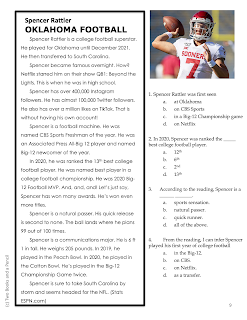Because formative assessment isn’t used for grading, students are comfortable making mistakes and asking for help. They are free to do their work, without the cloud of a grade hanging over them. Evidence suggests that the best students use all information formatively. Struggling students, however, are more apt to have negative feelings after failure. These feelings often get in the way of student learning. For struggling students, the value of any feedback is lost – overshadowed by low grades. Formative assessment offers the opportunity for every student to learn to use and value feedback.
What Formative Assessment Looks Like in a Fifth Grade Classroom
Close your eyes and imagine you are a fifth-grade teacher and today’s learning goals include applying reading standards for informational text, specifically: RL 5.1.1 and 5.1.2: Quote accurately from a text when explaining what the text says explicitly and when drawing inferences from the text.
This is a new skill for fifth grade and difficult for older struggling readers. For the those still trying to decode and understand the text - they only why they are going to learn to draw inferences is by reading text that is at their level, but doesn't look "primary."
This example is from the resource: 20 High Interest Low Level Reading Comprehension Passages Grades 5-12 - Random Sports
Have students read the following passage from the resource. It is at a 3.5 grade reading level. For resources at lower reading levels - see below. I have students read and think-pair-share the inference sheet.
As students work in pairs through the inference sheet I work through it verbally with the struggler(s). Hint - I have a three-ring binder open to a page with the headings: Child’s Name/Date, RL 5.1 Making Inferences, Teaching Point and What’s Next for this Child? Farther down the page is a sticky note listing two to three students’ names. These are the students I will assess today. I say: "We are working on inference - in other words – coming to a conclusion made by connecting what we know with the reading.
So, we read the article. Let's read the inference paragraph. Read between the lines and tell me what you can infer from the reading, title and photos about the kind of football playing Spencer is. Follow up questions should be determined by student answers.

After you work with individual students, circulate the room and gauge how all students are grasping the lesson. If they aren't pull together a mini-lesson from this resource or the resources listed below.
You’ve quickly and simply learned what students know and do not know, you have the information tucked away in your binder and should continue to refer to the information in your binder to drive instruction.
Inference for older students at lower reading levels.
Grade Level 2-3:
20 High Interest: Low Level Reading & Comprehension Passages Grades 5-12: Set 4
Grade Level 2:
20 SUPERHERO Hi Low Reading Comprehension Passages, Activities Standards Aligned
#readingcomprehension #reading #intervention #scienceofreading






No comments:
Post a Comment